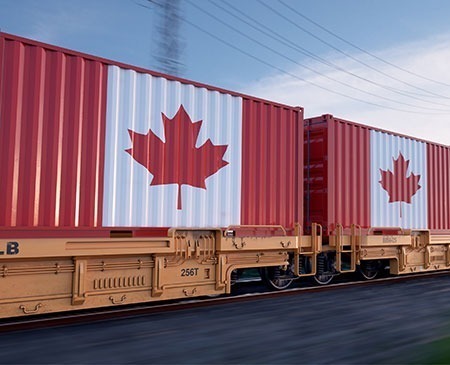2025 Guide for Smarter Logistics
Shipping in Canada has never been more critical – or more complex – than it is in 2025. With rising consumer expectations, evolving trade regulations, growing e-commerce, and regional infrastructure challenges, businesses across the country are under increasing pressure to streamline their logistics. Whether you’re shipping domestically within provinces or managing cross-border logistics between Canada and the U.S., success in shipping in Canada now demands a smarter, more strategic approach.
As a country defined by vast geography, regional weather extremes, and varying regulatory landscapes, shipping in Canada isn’t a one-size-fits-all operation. What works in southern Ontario might not work in northern British Columbia. Routes that are cost-effective in summer may become liabilities in winter. Add in cross-border customs complexities, transportation capacity constraints, and evolving sustainability goals, and it’s clear that shipping in Canada requires careful planning, the right partnerships, and constant adaptation.
This guide breaks down the seven crucial factors that logistics professionals, retailers, manufacturers, and e-commerce businesses must understand to navigate shipping in Canada successfully in 2025. Whether you’re new to logistics or a seasoned supply chain manager, these insights will help you minimize disruptions, cut costs, and deliver reliably—no matter where you operate in the country.

Why Getting Shipping Right Matters in Canada
Canada’s economy is heavily reliant on trade and freight movement. With over 38 million people spread across a massive landmass, efficient logistics are essential for everything from grocery store shelves to industrial supply chains. Delays in shipping in Canada don’t just impact your bottom line – they ripple through your customer experience, reputation, and growth potential.
Moreover, shipping expectations in 2025 have evolved. Customers now expect same-day or next-day delivery in urban centres, real-time tracking, and eco-conscious shipping options. Businesses are also navigating increased costs for fuel, labour shortages in transportation sectors, and pressure to adopt more sustainable practices. In this environment, the companies that understand and plan for the intricacies of shipping in Canada will outperform those that rely on outdated or reactive approaches.
The Unique Challenges of Shipping in Canada
Before we dive into the seven key factors, it’s worth understanding what makes shipping in Canada particularly challenging:
- Geographic scale and diversity: Canada is the second-largest country in the world by land area. Shipping from Vancouver to Halifax covers nearly 6,000 km – similar to moving goods across all of Europe.
- Climate and seasonal disruption: Snow, ice, wildfires, and flooding can shut down transport corridors at a moment’s notice, especially in northern and rural regions.
- Limited rural infrastructure: Reaching remote or sparsely populated areas often means higher costs and longer delivery windows.
- Cross-border complexity: The U.S. remains Canada’s largest trading partner, and cross-border shipping in Canada involves customs paperwork, duties, taxes, and regulatory compliance.
- Regulatory differences by province: Each province has its own transportation rules, which can complicate domestic logistics.
- Labour and trucking shortages: Canada continues to face a shortage of qualified truck drivers, pushing many shippers to explore intermodal or regional alternatives.
- Sustainability pressures: New carbon pricing, emissions tracking, and eco-friendly packaging expectations are shaping the way shipping is done across the country.
Understanding these challenges is the first step. Overcoming them starts with smart planning, which is exactly what the next section will help you do.
Who Needs This Guide?
If you’re involved in any aspect of product movement – whether you manage outbound logistics, oversee procurement, or run a growing e-commerce store – this guide is designed for you. It’s particularly relevant for:
- Canadian retailers looking to reduce delivery delays and improve customer satisfaction.
- Cross-border shippers managing logistics between the U.S. and Canada.
- Manufacturers and distributors balancing shipping costs with inventory goals.
- Third-party logistics (3PL) providers optimizing multi-modal delivery networks.
- E-commerce startups struggling with last-mile delivery across Canada’s vast geography.
The good news? You don’t need to reinvent your supply chain. You just need to understand the right factors that drive efficient, reliable, and cost-effective shipping in Canada – and how to plan for them.

The State of the Shipping in Canada
Shipping in Canada is critical in transporting goods within and beyond Canada’s borders, supporting the nation’s economic activities. Canada has a well-developed network of ports, railways, and highways facilitating domestic and international trade.
Canada’s major ports include:
- The Port of Vancouver: Is Canada’s largest and busiest port, handling over $175 billion in trade annually. It is a critical gateway for trade with Asia, particularly China. It primarily handles containers, bulk, and breakbulk cargo.
- The Port of Montreal: It is the second largest port, which sees over $134 billion in trade annually. It serves as an Eastern hub, connecting to markets in Eastern Canada, the U.S. Great Lakes region and the Atlantic. It specializes in containers, bulk, and roll-on roll-off cargo.
- The Port of Prince Rupert: It is a deep water port and vital Pacific gateway for trade with Asia. It provides the fastest transit time to Asian markets for cargo originating in Canada. It focuses on containers and bulk shipments.
Canada exports various goods like metals, minerals, agricultural products, and refined oil. Imports include machinery, equipment, motor vehicles, and consumer goods. As a resource-rich nation, many exports include coal, potash, wheat, and crude oil shipped by rail and pipeline.
Despite its importance, shipping in Canada faces challenges from rising operating costs, labor shortages, and supply chain disruptions. However, with the new Canada-U.S.-Mexico trade deal and growing demand from Asian markets, Canada’s ports and shipping networks continue to modernize and expand to capture more trade flows.
The logistics industry in Canada has evolved rapidly in recent years. In 2025, five trends are reshaping how businesses approach shipping in Canada:
- Digital transformation in logistics: Real-time tracking, AI-driven route optimization, and cloud-based TMS platforms are helping businesses manage complexity with greater visibility.
- Shift toward intermodal transport: Rising fuel costs and sustainability goals are making rail and intermodal shipping more attractive for long-haul freight.
- Expanded warehousing networks: To reduce delivery windows, many businesses are adopting decentralized warehousing strategies across multiple provinces.
- Sustainable shipping incentives: Federal and provincial programs now reward businesses for reducing emissions, using electric vehicles, or offsetting carbon impact.
- Growth of cross-border e-commerce: With more U.S.-based businesses selling to Canadians—and vice versa—navigating cross-border compliance is more critical than ever.
These changes are shaping the future of shipping in Canada, requiring businesses to stay informed, agile, and proactive.
Challenges in the Canadian Shipping Industry
Shipping in Canada faces several challenges that threaten its competitiveness and growth potential. Some of the key issues include:
High Costs
When comparing shipping costs in Canada and other countries, they have a higher shipping price, particularly for domestic freight shipping. The lack of cheap shipping is mainly due to long distances, small domestic market size, and lack of a vast transportation network. High shipping prices make Canadian exports less competitive globally and imported goods more expensive for Canadian consumers.
Infrastructure Constraints
Canada’s ports, railways, and roads used for shipping have infrastructure constraints that limit their efficiency and capacity. Ports, in particular, cannot handle larger cargo ships, and railroads face issues with congestion and delays. These infrastructural problems raise shipping costs and reduce reliability.
Regulatory Complexities
Shipping in Canada involves a complex web of federal, provincial, and municipal regulations governing different industry aspects. Navigating this regulatory complexity raises compliance costs and creates uncertainty for businesses. There have been calls for a more harmonized and streamlined regulatory environment.
Rising Fuel Costs
Fuel costs, particularly diesel fuel, have risen steadily in recent years. Since fuel is a major input cost for the shipping industry, higher fuel prices translate directly into higher shipping rates, lowering the competitiveness of Canadian exports.
Workforce Shortages
Certain segments of the Canadian shipping industry, particularly the trucking sector, have been experiencing labor shortages. An aging workforce and difficulties attracting new entrants have created labor constraints that threaten the ability of the industry to meet rising demands of shipping in Canada.

The Role of Technology in Modernizing Shipping Operations
The shipping service and logistics industry has traditionally been slow to adopt new technologies. However, rising customer expectations, increased competition, and narrowing margins have boosted technological adoption. Technology is critical in modernizing shipping operations, improving efficiency, and reducing costs.
Advances in automation and online shipping tools are streamlining port operations. Automated stacking cranes and guided vehicles are now widely used to load and unload cargo from ships and transport them within terminals. This element reduces the need for manual labor and improves the speed and productivity of port operations.
Telematics and fleet management technologies are helping shipping companies optimize fleet utilization and driver performance. Devices that track location, fuel usage, driving behavior, and cargo conditions allow fleet managers to identify efficiency gaps, reduce fuel costs, and allocate resources better.
New supply chain software solutions like warehouse management, transportation, and ocean/road freight tracking systems bring much-needed visibility, traceability, and automation to shipping volume operations. These help synchronize processes, track shipments in real-time, and identify bottlenecks and delays quickly.
Technologies like big data analytics, AI, machine learning, and IoT sensors now enable predictive analytics capabilities that can optimize routes, predict machine failures, calculate shipping costs, forecast demand, and detect anomalies earlier. These insights help shipping companies make smarter, data-driven decisions.
Trade Agreements and International Partnerships
Shipping in Canada and trade rely heavily on participation in global agreements and partnerships with international counterparts. Several major trade deals have helped expand opportunities for Canadian shipping. These are some significant international trade agreements benefiting Canadian shipping.
- NAFTA: The North American Free Trade Agreement eliminated tariffs on most goods traded between Canada, the U.S., and Mexico. This opened up one of the cheapest shipping lanes and increased trade volumes between the three countries.
- CETA: The Canada-EU Comprehensive Economic and Trade Agreement reduced tariffs and bureaucratic barriers to trade between Canada and the European Union. EU countries are Canada’s major trade partners, facilitating more shipping traffic.
- TPP: The Trans-Pacific Partnership (now CPTPP without the U.S.) lowered tariffs and trade barriers among Canada, Australia, New Zealand, Japan, and other Asia-Pacific countries. This step opened up new shipping routes for Canadian exporters and importers.
- WTO: Canada’s membership in the World Trade Organization stabilizes trade relations and settles disputes through a rules-based system. It provides certainty for Canadian shipping companies involved in international trade.
- FTA with South Korea: The Canada-South Korea Free Trade Agreement eliminated tariffs for many goods traded between the two countries. This increased shipping demands, especially for Canadian resource exports to South Korea.
Role of International Partnerships in Expanding Shipping Opportunities
Beyond trade deals, Canadian shipping companies partner with their international counterparts through agreements, joint ventures, and alliances. This allows them to share expertise, networks, and infrastructure to expand the reach of their operations.
For example, shipping alliances among all the major carriers offer Canadian shippers more frequent sailings and direct routes. Canadian ports have partnered with key foreign ports to streamline logistics and transportation connections.
International partnerships will continue to play an essential role in helping Canadian shipping companies diversify, access new markets, and remain globally competitive. Leveraging the country’s strong trade relationships will be key to supporting the future growth of the Canadian shipping sector.
Shipping within Canada presents challenges due to the nation’s vast size and diversity. However, Canada’s well-established transportation networks and logistics infrastructure allow for the efficient flow of goods across the country. With improvements in transportation technologies and operational streamlining, shipping costs in Canada are continuously declining while reliability rises.
As e-commerce grows, Canadian shippers must adapt further to meet evolving consumer demands and expectations around fast and cost-effective shipping options. With a focus on innovation, sustainability, and customer experience, the future of shipping in Canada looks promising and poised better to connect businesses and consumers across this great nation. Canada’s shippers and logistics providers will continue rising to meet the Canadian people’s and economy’s shipping needs in the years ahead.
The Future of Shipping in Canada: What’s Next?
So where is the Canadian shipping industry headed?
Looking ahead, we expect to see a continued rise in:
- AI-powered logistics planning: Predictive analytics and machine learning will further optimize routing, forecasting, and resource allocation.
- Electrification of last-mile delivery: As EV infrastructure improves, fleets across Canada will go greener.
- Decentralized warehousing: Distributed fulfillment centers will help reduce shipping distances and meet 1-2 day delivery expectations.
- Smart customs clearance: API-integrated trade documents and real-time customs data will reduce delays at the border.
- Dynamic pricing models: As the industry gets more data-savvy, shipping rates will adjust in real time based on demand, weather, and capacity.
Businesses that prepare for these trends today will thrive tomorrow. And those that wait? They risk being left behind – paying more, delivering slower, and competing with better-prepared rivals.
How to Take Action Now
If you’ve made it this far, it means you care about improving your logistics and succeeding in the Canadian market. That’s exactly the kind of mindset that turns a shipping department into a strategic asset.
So, what’s your next step?
Here’s how to begin:
- Audit your current shipping operations: Are you overpaying? Underperforming? Where are your friction points?
- Map your key shipping zones: Identify your highest-volume lanes and evaluate carrier performance and regional fit.
- Evaluate cross-border workflows: Are your customs processes efficient and digitally enabled?
- Explore modal diversification: Are there intermodal or regional partners that could lower your costs and increase reliability?
- Prioritize visibility and data: Are you tracking shipments in real time and analyzing performance?
- Find the right logistics partner: Are you working with a provider who truly understands the complexity of shipping in Canada?
If you’re unsure where to begin, that’s where we come in.
RGW: Your Trusted Partner for Seamless Shipping in Canada
At RGW, we specialize in helping businesses navigate the full complexity of shipping in Canada – from coast to coast and across the border. We’re not just a freight broker or a shipping platform. We’re a strategic logistics partner who understands the terrain, the tech, and the regulations that define success in Canadian freight.
Whether you’re moving truckloads across provinces, managing B2C fulfillment, or optimizing a cross-border supply chain, RGW brings together:
✅ Tailored carrier networks optimized for Canadian routes
✅ End-to-end visibility tools for real-time shipment tracking
✅ Customs compliance expertise for seamless U.S.-Canada movement
✅ Sustainable shipping solutions to meet your carbon goals
✅ Data-driven logistics strategy that helps you ship smarter, faster, and more profitably
We’re committed to helping our clients not only meet the demands of 2025 – but exceed them.
Let’s Redefine What Hassle-Free Shipping in Canada Looks Like
There’s no shortcut to success in shipping in Canada, but there is a smarter way to get there. One that’s rooted in data, driven by technology, and built on trusted relationships. At RGW, we’ve helped countless businesses transform their logistics from a cost center into a growth driver – and we’d love to do the same for you.
🚚 Let’s simplify your shipping. Streamline your supply chain. And help you deliver on your brand promise – every time.
Contact RGW today to schedule a free shipping strategy session or to request a custom quote tailored to your Canadian logistics needs.
Stop reacting. Start optimizing. Trust RailGateway.
Additional Resources
Supply Chain Dive – Best Practices for Logistics Managers in 2025
https://www.supplychaindive.com/news/best-practices-for-logistics-managers-in-2025/743509/
Canada Border Services Agency – Customs Tariff 2025
https://www.cbsa-asfc.gc.ca/trade-commerce/tariff-tarif/2025/menu-eng.html
Rail Gateway – Rail Freight Canada: 7 Powerful Ways To Lower Transportation Costs
https://railgateway.ca/blog/lowering-costs-with-rail-freight
How We Can Help
For businesses looking to optimize their freight shipping with reliable, efficient, and cost-effective solutions, RailGateway.ca is your trusted partner in intermodal logistics. Whether you’re new to freight trains or want to enhance your existing supply chain, our team of intermodal experts is ready to guide you every step of the way.
Contact RailGateway.ca today for a free quote or to speak directly with one of our experienced intermodal specialists. Let us help you unlock smarter, smoother shipping solutions tailored to your unique needs.
Visit RailGateway.ca or call us to get started on transforming your freight shipping strategy in 2025 and beyond.





